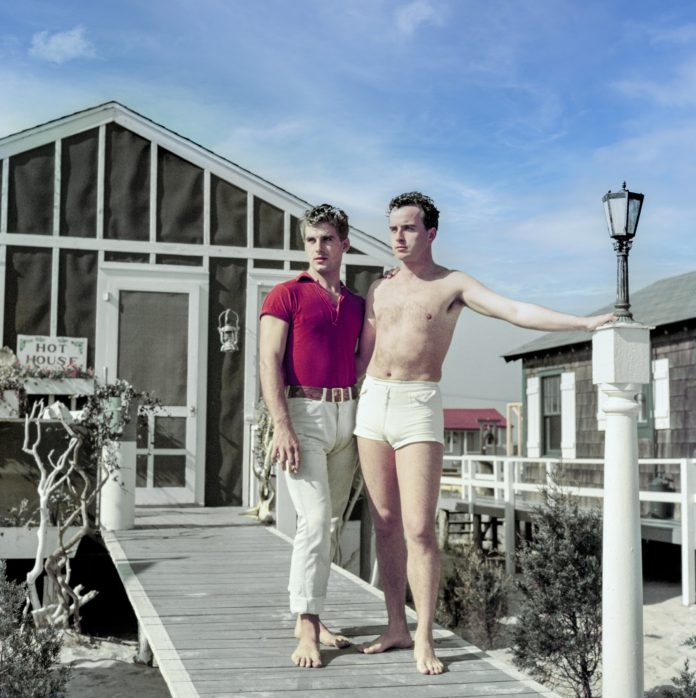Words: Will Stroude / Image: courtesy of the Cherry Grove Archive Collection
While it’s true that much of the LGBTQ experience in the age before decriminalisation consisted of furtive glances and clandestine meetings, a fascinating new exhibition in New York reminds us that, in some areas at least, gay life was able to flourish out in the open.
From May to October, the New-York Historical Society museum is hosting a rare collection of photographs and images documenting life in 1950s and ’60s Cherry Grove on New York’s Fire Island – an area which has remained a popular LGBTQ retreat ever since.

Hot House, 1958 (courtesy of the Cherry Grove Archive Collection)
Cherry Grove’s isolated location off Long Island – accessible in the mid-20th century only by ferry or seaplane – led to it becoming an LGBTQ safe haven from the 1930s onwards as writers, artists, dancers, theater people, and Hollywood celebrities were attracted to its sandy shores.
By the 1950s and ’60s, the small hamlet was home to one of the world’s most vibrant gay scenes, with gay men and women able to socialise openly on its beaches or at local hotspots such as Duffy’s Hotel bar, where they could enjoy same-sex dancing late at night.

Parasol Party (courtesy of the Cherry Grove Archive Collection)
Flamboyant costume parties which would have otherwise violated strict New York laws prohibiting ‘risqué’ attire and cross-dressing became a regular part of Cherry Grove’s social calendar.
Images on display at New-York Historical Society’s open-air exhibition ‘Safe/Haven: Gay Life in 1950s Cherry Grove’ give a fascinating and heartwarming insight into the lives of gay men and women who were able to experience love, friendship and unselfconscious self-expression at a time where they found their very identity criminalised.

Patricia Fitzgerald and Kay Guinness on Cherry Grove Beach, 1952 (courtesy of the Cherry Grove Archive Collection)
Sadly, and perhaps inevitably for the time, Cherry Grove’s growing renown at an LGBTQ haven during the 1950s led to a growing pushback from the area’s longstanding heterosexual residents, and police raids began to become common throughout the 1960s, with men in particular being vulnerable to arrest and subsequent exposure in local newspapers.
As the 1969 Stonewall Riots in nearby New York City sparked a growing wave of LGBTQ politicisation and emancipation, Cherry Grove was able to preserve its status as one of the USA’s most popular gay resorts.

Young Man Posing for Polaroid (courtesy of the Cherry Grove Archive Collection)
In 2013, the Cherry Grove Community House and Theatre was listed on the USA’s National Register of Historic Places – one of only a few sites included to date for their role in LGBTQ history.
Photographs from the exhibition will be on display at the New-York Historical Society from 14 May – 11 October, giving a new generation of LGBTQ people the chance to step back in time to an era that is now on the cusp of leaving living memory.

Diaper Party II (courtesy of the Cherry Grove Archive Collection)
“Cherry Grove on Fire Island became a weekend and summer destination for gay men and women in the pre-Stonewall era of the 1950s and 1960s,” said Dr. Louise Mirrer, president and CEO of New-York Historical.
“At a time when they faced homophobia and persecution, the residents of Cherry Grove found a sanctuary where they could socialize and express themselves freely. We are proud to partner with the Cherry Grove Archives Collection to display these joyful images.”

Hot House weekend guest (courtesy of the Cherry Grove Archive Collection)
Susan Kravitz from the Cherry Grove Archives Collection adds: “The Cherry Grove Archives Collection is honored to exhibit our 1950s Cherry Grove photographs and ephemera at the New-York Historical Society.
“As you walk around this exhibition, we hope you will become aware of the joyous freedom of expression that LGBTQ people demonstrate in so many of these photographs, remembering that pre-Stonewall 1950s was a time when persecution and prosecution ruled the lives of homosexuals in mainland America.

Outside Bea Greer’s Home (courtesy of the Cherry Grove Archive Collection)
“Yet the 1950s was a richly creative historical period in Cherry Grove when gay and straight people worked and played together, whether in theatrical productions, costumed cocktail parties, annual balls, or a range of community-sponsored events.”
The New-York Historical Society presents Safe/Haven: Gay Life in 1950s Cherry Grove from 14 May – 11 October 2021.
Tickets for the free outdoor exhibition can be booked here.








